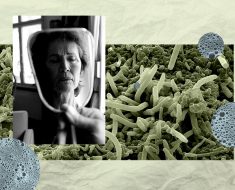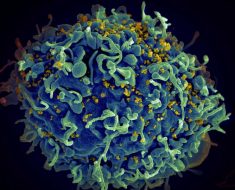Genetic alterations that give rise to a rare, fatal disorder known as MOGS-CDG paradoxically also protect cells against infection by viruses. Now, scientists at the Lewis Katz School of Medicine at Temple University have harnessed this unusual protective ability in a novel gene-editing strategy aimed at eliminating HIV-1 infection with no adverse effects on cell mortality.
The new approach, described online April 28 in the journal Molecular Therapy – Nucleic Acids, is based on a combination of two gene-editing constructs, one that targets HIV-1 DNA and one that targets a gene called MOGS – defects in which cause MOGS-CDG. In cells from persons infected with HIV-1, the Temple researchers show that disrupting the virus's DNA while also deliberately altering MOGS blocks the production of infectious HIV-1 particles. The discovery opens up new avenues in the development of a cure for HIV/AIDS.
Proper MOGS function is essential for glycosylation, a process by which some cellular proteins synthesized in the body are modified to make them stable and functional. Glycosylation, however, is leveraged by certain kinds of infectious viruses. In particular, viruses like HIV, influenza, SARS-CoV-2, and hepatitis C, which are surrounded by a viral envelope, rely on glycosylated proteins to enter host cells.
In the new study, lead investigators Kamel Khalili, PhD, Laura H. Carnell Professor and Chair of the Department of Microbiology, Immunology, and Inflammation, Director of the Center for Neurovirology and Gene Editing, and Director of the Comprehensive NeuroAIDS Center at the Lewis Katz School of Medicine, and Rafal Kaminski, PhD, Assistant Professor at the Center for Neurovirology and Gene Editing at the Lewis Katz School of Medicine designed a genetic approach to exclusively turn on CRISPR to impede MOGS gene expression through DNA editing within immune cells that harbor replication competent, HIV-1. Their novel approach is expected to avoid any impact on the health of uninfected cells that retain normal MOGS gene function. Stimulation of the apparatus in HIV-1 infected cells disrupted the glycan structure of the HIV-1 envelope protein, culminating in the production of non-infectious virus particles.
"This approach is conceptually very interesting," said Dr. Khalili, who is also senior investigator on the new study. "By mitigating the ability of the virus to enter cells, which requires glycosylation, MOGS may offer another target, in addition to the integrated viral DNA for developing the next generation of CRISPR gene-editing technology for HIV elimination."
Dr. Kaminski, Dr. Khalili, and Tricia H. Burdo, PhD, Professor and Vice Chair in the Department of Microbiology, Immunology, and Inflammation and the Center for Neurovirology and Gene Editing at Temple and an expert in the use of non-human primate models for HIV-1, have been working together to further assess the efficacy and safety of CRISPR-MOGS strategy in preclinical studies. In previous work, the team demonstrated that CRISPR-based technology can successfully remove viral DNA from the cells of infected non-human primates.
Other researchers who contributed to the study include Hong Liu, Chen Chen, Shuren Liao, and Shohreh Amini, Department of Microbiology, Immunology, and Inflammation, Center for Neurovirology and Gene Editing, Lewis Katz School of Medicine at Temple University; Danielle K. Sohaii, Conrad R.Y. Cruz, and Catherine M. Bollard, Center for Cancer and Immunology Research, Children's National Health System, The George Washington University; Thomas J. Cradick and Jennifer Gordon, Excision Biotherapeutics, San Francisco, CA; Anand Mehta, Stephane Grauzam, and James Dressman, Department of Cell and Molecular Pharmacology, Medical University of South Carolina; and Carlos Barrero and Magda Florez, Department of Pharmaceutical Sciences, School of Pharmacy, Temple University.
The research was supported in part by grants from the National Institutes of Health and the W.W. Smith Charitable Trust.
Temple University Health System
Liu, H., et al. (2023) Strategic Self-Limiting Production of Infectious HIV Particles by CRISPR in Permissive Cells. Molecular Therapy — Nucleic Acids. doi.org/10.1016/j.omtn.2023.04.027.
Posted in: Molecular & Structural Biology | Cell Biology
Tags: AIDS, Bioethics, Biotherapeutics, Cancer, Cell, Children, CRISPR, DNA, Education, Efficacy, Gene, Gene Expression, Gene-Editing, Genetic, Glycan, Glycosylation, Heart, Heart Disease, Hepatitis, Hepatitis C, HIV, HIV/AIDS, HIV-1, Hospital, Immunology, Inflammation, Influenza, Medicine, Metabolic Disease, Microbiology, Mortality, Next Generation, Pharmacology, Pharmacy, Preclinical, Protein, Research, SARS, SARS-CoV-2, students, Substance Use Disorder, Technology, Virus
Source: Read Full Article





